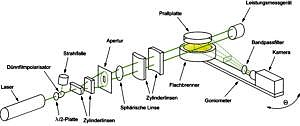Measurement of Aggregate Morphology with Two-Dimensional Multi-Angle Light Scattering

Here Elastic Light Scattering is used in an imaging approach for the detection of soot formation in combustion processes. The angular dependent scattered light is detected spatially resolved by a camera on a goniometer under various detection angles by rotating the camera. From the scattering intensities the radius of gyration and the fractal dimension of the aggregates can be determined with a very high spatial resolution.
In order to obtain sharp images even under extreme measurement angles an automated view camera is employed for the first time, allowing to repeatably adjust the camera following the so called Scheimpflug principle for each measurement angle with a very high precision. For further image processing of the obtained scattering images an image transformation is applied to account for changing magnification factors. Afterwards all images are linked with a global coordinate system.
This procedure allows for the investigation of laminar premixed and diffusion flames. By a combination with other imaging measurement techniques, such as 2D Laser-Induced Incandescence, soot formation processes can be characterized comprehensively, the results afterwards being used for numerical simulations of combustion processes.
Literatur
- , , , , :
Soot aggregate sizing in an extended premixed flame by high-resolution two-dimensional multi-angle light scattering (2D-MALS)
In: Applied Physics B-Lasers and Optics 125 (2019)
ISSN: 0946-2171
DOI: 10.1007/s00340-019-7282-0
